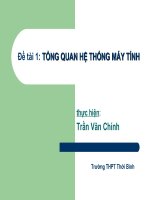BAI GIANG VE NAO BO (BRAIN)
Bạn đang xem bản rút gọn của tài liệu. Xem và tải ngay bản đầy đủ của tài liệu tại đây (2.19 MB, 30 trang )
Cuøng vôùi
Central nervous system, along with
endocrine system, control over
animal’s physiology and behaviors
Common structural organization of all vertebrate brains
:
• Three main regions:
₋ forebrain (telecephalon and
diencephalon)
₋ midbrain (mesencephalon)
₋ hindbrain (metencephalon
and myelencephalon)
•In high vertebrates, the
cerebellar cortex, cerebral
cortex are prominent
Hill.Wyse.Anderson. Animal physiology.2e.Sinauer Associates, 2008
The structure of human brain
Naừo trửụực
Forebrain:
Cerebrum
Cerebral cortex
Subcortical nuclei
Diencephalon:
Thalamus
Hypothalamus
Tieồu naừo
Cerebellum
Brain stem:
Tiu nóo
Midbrain
Pons cau naừo
Medulla oblongata
1360-1450g
soù
12 pair s of cranial nerves
C.L. Standfield.2011. Principles of Human Physiology, 4th edition.
Gray matter and white matter
• Gray matter (40% of CNS):
cell bodies, dendrites, axon
terminals- synaptic
communication and neural
integration
• White matter (60% of
CNS):bundles of axons
connecting regions of gray
matter: association fibers,
projection fibers, commissural
fibers
Boù
Nhoâ ra, loài ra
C.L. Standfield.2011. Principles of Human Physiology, 4th edition.
Choã noái
Cranial nerves
C.L. Standfield.2011. Principles of Human Physiology, 4th edition.
Vỏ
Cerebral cortex – functional organization
Ngoài cùng
• Outermost portion of the cerebrum with
Nếp, cuộn
high convolutions of thin gray matter
layer (1-4 mm thick)
•Six functionally distinct layers of cortex
Thùy trán
Thùy đỉnh
•Gyrus (plr. Gyri), sulcus (sulci)
Thùy chẩm
Rãnh bên
•Central sulcus and lateral sulcus
Bán cầu não
Thùy thái dương
• Each cerebral hemisphere: 4 lobes:
frontal, parietal, occipital, temporal
C.L. Standfield.2011. Principles of Human Physiology, 4th edition.
The cerebral cortex is divided into
functional areas
• Main functional areas:
– Sensory areas
•
primary sensory cortex
– Motor areas
•
primary motor cortex
– Association areas
söï leäch hoùa
• Brain lateralization:
Certain brain functions are dominant
on one side of the brain relative to
the other: the left side of the brain
controls movements of the right
side of the body and vice versa
C.L. Standfield.2011. Principles of Human Physiology, 4th edition.
Primary motor cortex and primary somatosensory cortex are
topoghraphically organized: the motor and sensory homunculi
Hill.Wyse.Anderson. Animal physiology.2e.Sinauer Associates, 2008
Vuøng ñoài thò
Thalamus
• a cluster of nuclei functioning as a
relay centrer
• Sensory information-> thalamus
(filter, refine information-> cerebral
cortex->Important in directing
attention
• Information from cerebellum and
basal ganglia ->thalamus->motor
cortex: feedback in controlling
movement
C.L. Standfield.2011. Principles of Human Physiology, 4th edition.
Vùng dưới đồi
Hypothalamus
• is the major link between endocrine and nervous system
regulating homeostasis
• is one of the main centers of hormone production and
control
Thỏa mãn
Đói
Khát
• contains satiety, hunger, and thirst centers regulating eating,
drinking behaviors
• contains thermoregulatory centers regulating body
temperature
Biên, viền
• is a part of the limbic system-> affects emotions and
behaviors in response to emotions
• has direct and indirect inputs to the autonomic nervous
system
• has the suprachiasmatic nucleus generating and regulating
circadian rhythm
Bieân, vieàn
Limbic system
•
is a collection of closely associated
cortical regions, subcortical nuclei and
tracts in the forebrain functioning in
motivation, memory, and emotions
• is involved in basic drives:
– amyglada: aggression and fear
– hippocampus: learning and memory
C.L. Standfield.2011. Principles of Human Physiology, 4th edition.
Cerebellum
• Fine Movement Coordination
• Balance and Equilibrium
• Muscle Tone
Brain stem
• Location for nuclei of 10
from 12 cranial nerves
• Involves involuntary
control of posture
• regulates basic vital life
functions: centers for
cardiovascular and
respiratory activities
• Involves sleep-wake
cycles
C.L. Standfield.2011. Principles of Human Physiology, 4th edition.
Electroencephalogram (EEG)
web.lemoyne.edu/~hevern/psy340/lectures/psy34...
The spinal cord
•
the portion of CNS
surrounded by the vertebral
column
• nuclei for 31 pairs of spinal
nerves which are arranged
segmentally:
–
–
–
–
–
Fig.9.6 .C.L. Standfield.2011. Principles of Human Physiology, 4th edition.
8 cervical nerves (C1-C8)
12 thoracic nerves (T1-T12)
5 lumbar nerves (L1-L5)
5 sacral nerves (S1-S5)
1 coccygeal nerve (Co)
Dermatomes
• spinal nerves travel to
adjacent regions of the
body -> sensory regions
in the body’s surface
can be mapped out:
dermatomes
• clinicians/physicians
can use the map to find
the location of damage
to the spinal cord and
spinal nerves
Fig. 9.7 C.L. Standfield.2011. Principles of Human Physiology, 4 th edition.
Spinal cord gray matter
•
•
forms a butterfly shaped
region centering the spinal
cord
is organized into dorsal
and ventral regions:
–
–
•
Fig. 9.8 .C.L. Standfield.2011. Principles of Human Physiology, 4th edition.
dorsal horn: site of axon
terminals of sensory
neurons which have cell
bodies in dorsal root
ganglia;
ventral horn: site for cell
bodies of motor neuron
Lateral horns in the gray
matter of T1-L2 are the
sites preganglionic
neurons of the sympathetic
nervous system
The white matter of the spinal cord
Bó lên
• consists of tracts
connecting different
levels of the spinal
cord or between the
brain and the spinal
Bó xuống cord
- ascending tracts
- descending tracts
C.L. Standfield.2011. Principles of Human Physiology, 4th edition.
C.L. Standfield.2011. Principles of Human Physiology, 4th edition.
•
ascending and
descending tracts
generally cross over to
the opposite side of its
origin: contralateral
pathway
Left side of the
brain percieves
sensory information
from and exerts
motor control to the
right side of the
body, and vice
versa
•
some exceptions: the
tracts remain in the
same side of origin:
ipsilateral pathway
Reflex and components of a reflex arc
• Reflex is a response
of the body to a
stimulus
• Neural pathways for
reflexes are reflex
arcs
• A reflex arc consists
of 5 components
C.L. Standfield.2011. Principles of Human Physiology, 4th edition.
Classes of reflexes
C.L. Standfield.2011. Principles of Human Physiology, 4th edition.
Stretch reflex
Thoi cơ
• Knee-jerk
reflex/muscle spindle
stretch reflex
• The only known
monosynaptic reflex in
the human body
• muscle spindle
(receptor)-> afferent
neuron -> spinal cord>efferent neuron->
muscle (Hamstrings)
C.L. Standfield.2011. Principles of Human Physiology, 4th edition.
The autonomic nervous system
• controls visceral functions:
smooth muscles, glands
(exocrine and some endocrine
glands), acid-secreting cells of
the stomach, pacemaker region
of the heart, the brown adipose
tissue
• autonomous functions are
involuntary and unconscious
• has two main divisions:
– Sympathetic Nervous
System (SNS)/
thoracolumbar division
– Parasympathetic Nervous
System (PSNS)/
craniosacral division
Fig.14.11. C.L. Standfield.2011. Principles of Human Physiology, 4 th edition.
Common features of ANS
Hill.Wyse.Anderson. Animal physiology.2e.Sinauer Associates, 2008
• Motor pathways of ANS contain 2 neurons communicating through
peripheral synapses located in autonomic ganglia:
– Preganglionic neuron
– Postganglinonic neuron
• CNS-> Preganglionic neuron ->Postganglinonic neuron-> effectors
Neurotransmitters and receptors in
the ANS
• Neurotransmitters:
– preganglionic neuron of
ANS: acetylcholine (ACh)
−postganglionic neuron of
SNS: norepinephrine (NE),
epinerphrin (E)
–postganglionic neuron of
PSNS:acetylcholine (ACh)
• Receptors:
− for ACh: nicotinic
cholinergic receptor,
muscarinic cholinergic
receptors
−for E, NE: adrenergic
receptors
C.L. Standfield.2011. Principles of Human Physiology, 4th edition.









